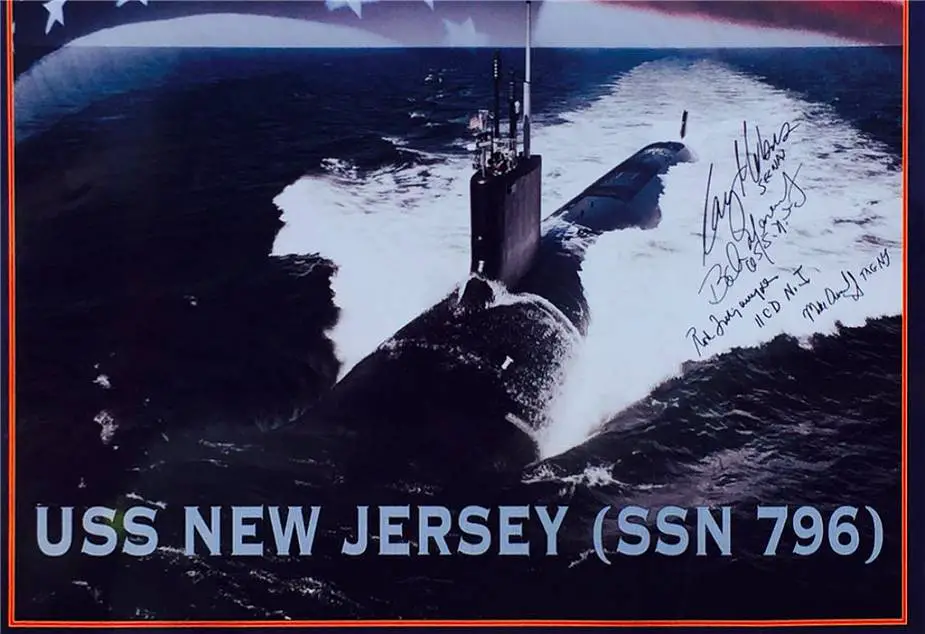Breaking news
US Navy USS New Jersey SSN 796 Virginia-class nuclear fast-attack submarine to be christened today.
According to information published by the United States Department of Defense, the U.S. Navy will christen one of its newest Virginia-class fast-attack submarines, the future USS New Jersey (SSN 796), during a ceremony on Saturday, November 13, 2021, at Huntington Ingalls Industry, in Newport News, Va.
Follow Navy Recognition on Google News at this link
 The USS New Jersey (SSN-796) is a nuclear powered Virginia-class attack submarine built for the U.S. Navy. (Picture source U.S. Navy)
The USS New Jersey (SSN-796) is a nuclear powered Virginia-class attack submarine built for the U.S. Navy. (Picture source U.S. Navy)
The future USS New Jersey (SSN 796) is the third Navy vessel named in recognition of the state and is the 5th Block IV Virginia-class submarine to be built.
The USS Jersey (SSN-796) is a nuclear powered Virginia-class attack submarine, design to operate in the world's littoral and deep waters while conducting anti-submarine warfare; anti-surface ship warfare; strike warfare; special operations forces support; intelligence, surveillance, and reconnaissance; irregular warfare; and mine warfare missions. Their inherent stealth, endurance, mobility, and firepower directly enable these submarines to support five of the six maritime strategy core capabilities – sea control, power projection, forward presence, maritime security, and deterrence. Virginia-class submarines are replacing Los Angeles-class fast-attack submarines as they retire.
The Virginia-class is a series of nuclear-powered cruise missile fast-attack submarines, in service in the United States Navy. Designed by General Dynamics's Electric Boat (EB) and Huntington Ingalls Industries, the Virginia-class is the United States Navy's latest submarine model, which incorporates the latest in stealth, intelligence gathering, and weapons systems technology.
The U.S. Navy has been procuring Virginia (SSN-774) class nuclear-powered attack submarines (SSNs) since FY1998, and a total of 34 have been procured through FY2021. Since FY2011, Virginia-class boats have been procured at a rate of two per year.
The first Virginia-class submarine entered service in October 2004. The Virginia-class design was developed to be less expensive and better optimized for post-Cold War submarine missions than the Seawolf-class design. The baseline Virginia-class design is slightly larger than the Los Angeles-class design but incorporates newer technologies, including technologies used in the Seawolf-class design.
The Virginia-class submarine includes Block I, II, III, IV, and V versions. Block I involved 4 submarines and modular construction techniques were incorporated during construction. Block II involved 6 submarines that were built in four sections rather than ten sections. Block III submarines feature a revised bow with a Large Aperture Bow (LAB) sonar array, as well as technology from Ohio-class SSGNs (2 VLS tubes each containing 6 missiles). Block IV involved 10 submarines. The main improvement over Block III is the reduction of major maintenance periods from four to three, increasing each boat's total lifetime deployments by one. Block V involves 10 boats and may incorporate the Virginia Payload Module (VPM), which would give guided-missile capability when the SSGNs are retired from service.
The Virginia-class submarine has a length of 114.8 m, a beam of 10.36 m, and a displacement of approximately 7,800 tons. The submarine can reach a top speed of 28 miles per hour (45 km/h). She has a crew of 132 people including 15 officers and 117 enlisted.
Citing the Naval-Technology website, the Virginia-Class attack submarine is equipped with 12 vertical missile launch tubes and four 533mm torpedo tubes. The vertical launching system has the capacity to launch 16 Tomahawk submarine-launched cruise missiles (SLCM) in a single salvo. There is a capacity for up to 26 mk48 ADCAP mod 6 heavyweight torpedoes and sub harpoon anti-ship missiles to be fired from the 21in torpedo tubes. Mk60 CAPTOR mines may also be fitted.


























